Over 1 million businesses worldwide use Amazon Web Services actively to modernize, develop, deploy, test, and maintain their software applications. And by doing so, they have achieved operational excellence and significant cost reductions.
A fine example of an organization that has benefitted immensely from AWS application modernization is Delaware North. With over 500 million customers served annually across 200 global locations, Delaware North is a world leader in food service and hospitality. Yet constant growth placed a huge strain on its legacy on-premises data center, causing rising costs and inefficient operations. In 2015, Delaware North executed a massive shift by moving most enterprise applications to AWS – a decision that shrunk its server footprint by 90% and is projected to save $3.5 million in 5 years.
Additional wins included enhanced disaster recovery and much faster deployment of new services. For instance, while provisioning business units previously took 2-3 weeks, now it requires just one day on AWS!
Is your business too considering modernizing legacy systems with AWS? If yes, this blog post has all the answers for you! Read on to learn more about why AWS is the ideal choice for migrating to the cloud and the best practices you should follow to ensure the success of your business’s modernization strategy.
Why is AWS the best choice for application modernization?
Guide to IT Managers for AWS Migration
Application modernization is the process of upgrading older systems and migrating them to a cloud-first model. Therefore, it involves the extraction of legacy code, its analysis, re-engineering, and migration to a new architecture.
AWS helps make the modernization process efficient through various advanced tools. It also offers many additional benefits; let’s look at them quickly.
#1. Reduced TCO
AWS provides tons of features for application modernization reducing the cost of infrastructure, development, and deployment. Additionally, it can reduce the total cost of ownership significantly with the pay-per-use model. That means you pay only for the instances that run and terminate them when not needed.
AdRoll leveraged AWS to reduce the total cost of ownership.
AdRoll has created a purpose-built Real-Time Bidding (RTB) platform for advertisers to develop retargeting ad campaigns which are highly personalized.
A significant challenge for AdRoll in 2014 was coping with massive data collected daily on the platform. RTB witnessed over 150 TB of data accumulated daily and needed to maintain a response rate of 100 milliseconds per request. So, AdRoll chose Amazon Web Services services to build a cloud-native RTB.
The modernized RTB platform uses 500 c3.4xlarge Amazon EC2 instances with the Amazon DynamoDB database to process more than 500,000 requests per second. Moreover, AdRoll leverages Amazon S3 to store more than 150 TB daily.
Using the AWS services, AdRoll managed to reduce the cost of staffing by over $3 million! On top of that, it deployed a 180 TB storage environment on Amazon S3 with a 10% lower cost than an on-premise data center.
AdRoll understood AWS’s cost efficiency and migrated its most important platform to the cloud. In this way and many more, any organization can leverage Amazon Web Services to reduce the cost of infrastructure, staffing, and computing resources required for application modernization.
#2. Competitive advantage
A large number of businesses, especially eCommerce brands, have seen massive benefits of modernization post-2020. Due to widespread restrictions on physical activities in 2020, companies had to find new ways to work internally and serve their customers continually.
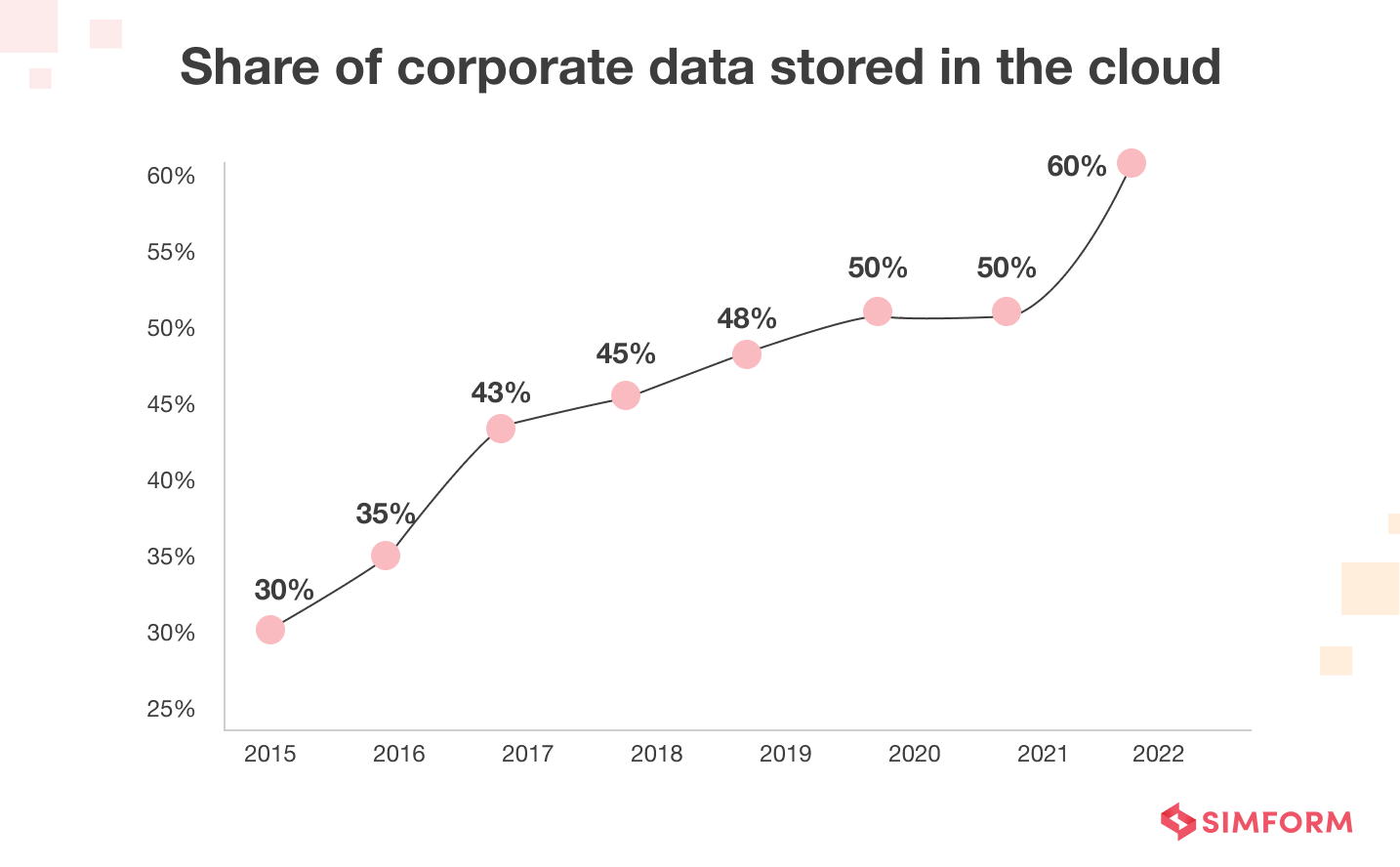
This prompted many offline retailers to modernize their existing applications. According to Zippia, 60% of all corporate data is stored on the cloud, and over 61% of organizations have already moved to the cloud by the end of 2022!
Amazon Web Services have fueled the cloud migration excellence for many such businesses and helped them benefit from cloud-native systems. AWS gives companies a competitive edge by providing them with features like
The capability to quickly create and deploy applications in the cloud, using best-in-class tools like Elastic Beanstalk and Amazon Container Service. This reduces time to market to a great extent; hence, your business gets a headstart.
The ability to combine multiple AWS services into single logical partitions for simplified management and monitoring. This lets you track your cloud costs, scale up or down resources as needed, connect more devices to the cloud, or run different workloads on separate instances without affecting each other.
As a result, your tech teams can achieve higher efficiency in developing and maintaining your business applications.
#3. Better observability
Successful modernization projects require enhanced observability to improve the resilience of the systems. AWS offers deep visibility into applications, customer journeys, and business outcomes. Some of the critical data that you need for better observability are:
- Data on end-user experience
- Performance of apps
- Dependencies of legacy applications
- Resource usages
- Bottlenecks of existing components
Observability has three key pillars: metrics, logs, and traces. AWS equips organizations with better observability tools like Amazon CloudWatch, AWS Distro for OpenTelemetry (ADOT), and more.
AWS Distro for OpenTelemetry (ADOT) is an essential tool that you can use to collect distributed traces and metrics for enhanced observability.
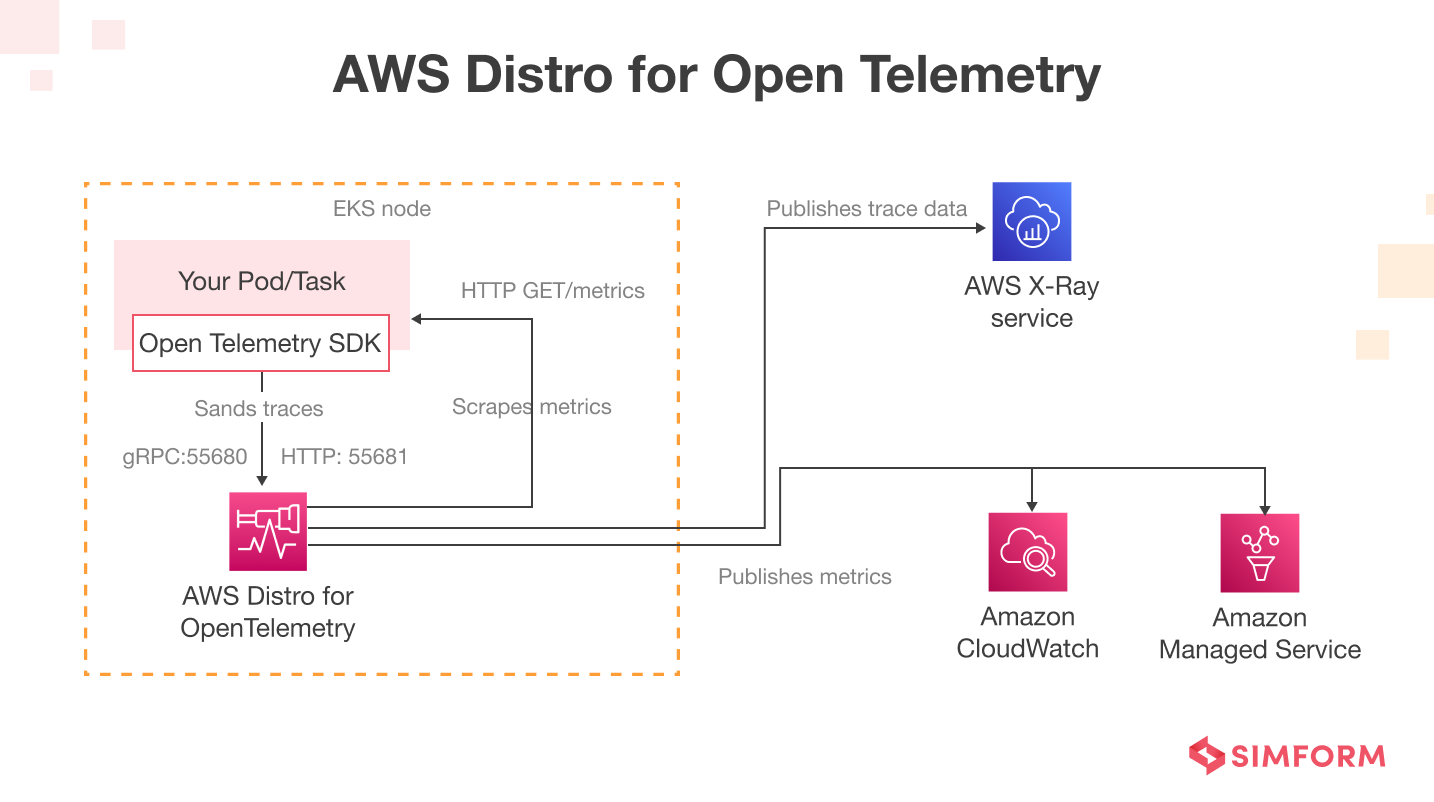
To make the best of ADOT, you can build a microservice in Python and run it in a container on Amazon Elastic Kubernetes Service (EKS). After that, deploy an ADOT collector to publish traces to AWS X-Ray and send metrics to Amazon CloudWatch.
You can leverage Amazon CloudWatch to monitor resources and applications that run on AWS in real-time, making observability far more effective.
#4. Reduced database dependencies
Legacy applications have mainframe workloads tightly coupled with the monoliths. Furthermore, such applications can have millions of code lines, and modernizing them for business agility can take time and effort.
If you plan to rewrite a legacy application for cloud-native architecture manually, re-engineering the effort will be massive. It involves re-engineering functions, data models, test cases, and integrations. AWS accelerates the mainframe transformation to containers through automated refactoring.
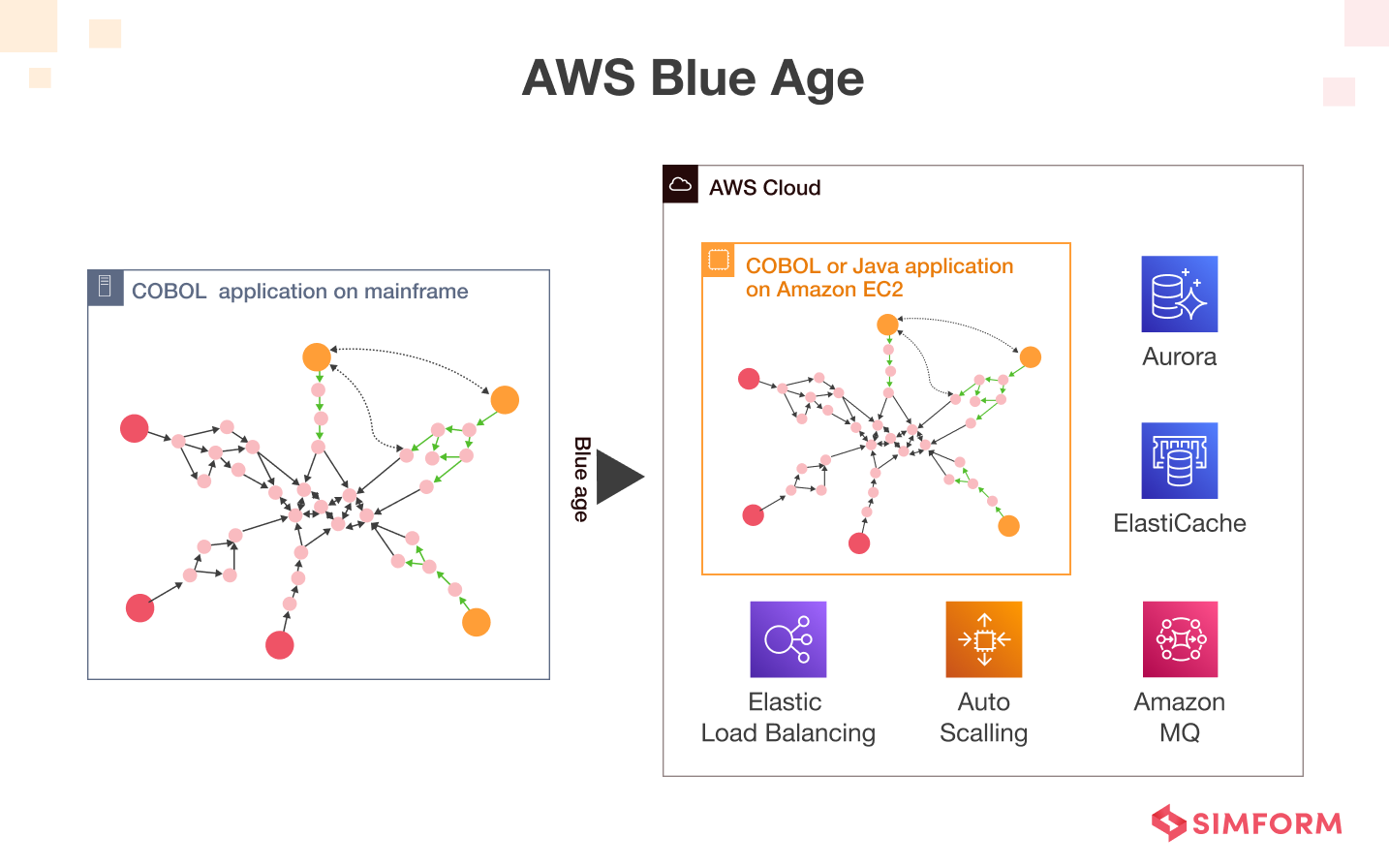
You can use AWS Blue Age which offers refactoring automation for a faster and more efficient modernization process. For example, in the case of COBOL application modernization, the Blu Age analyzer visualizes the components, programs, and data elements.
Based on the visualization, you can transform the mainframe application to be deployed on Amazon EC2. It offers multiple instance types, horizontal scalability, auto-scaling, managed services, and infrastructure automation.
All these features make working with data extremely simple, regardless of the scale of the application.
#5. Enhanced security and compliance
One of the most customizable and secure cloud computing environments available today is AWS. It’s built to offer highly scalable, dependable, and secure cloud-native app deployments. Not only do these Amazon Web Services follow cybersecurity best practices and standards, but they are also designed with the cloud-native aspects in mind.
AWS employs layered controls, continuous validation and testing, and considerable automation to guarantee that the underlying infrastructure is monitored and protected. According to AWS, every new data center or service must have these security controls.
Every AWS client benefits from a data center and network structure constructed to meet the demands of regulatory compliances like GDPR and HIPPAA. Pre-built IAM tools also allow organizations to enforce security policies efficiently.
#6. Higher-performance
Software systems execute business-critical functions that must be resilient, scalable, and cost-effective. It is essential to design application and cloud infrastructure architectures that meet the project’s performance requirements.
Performance requirements can help determine critical metrics like app response time, transactions per second, and others.
Amazon Web Services enable organizations to improve application responsiveness and handle more transactions per second through spot instances.
The best part is that you can leverage instant spot instances to address the growing user base of applications and terminate them after the traffic is stable again.
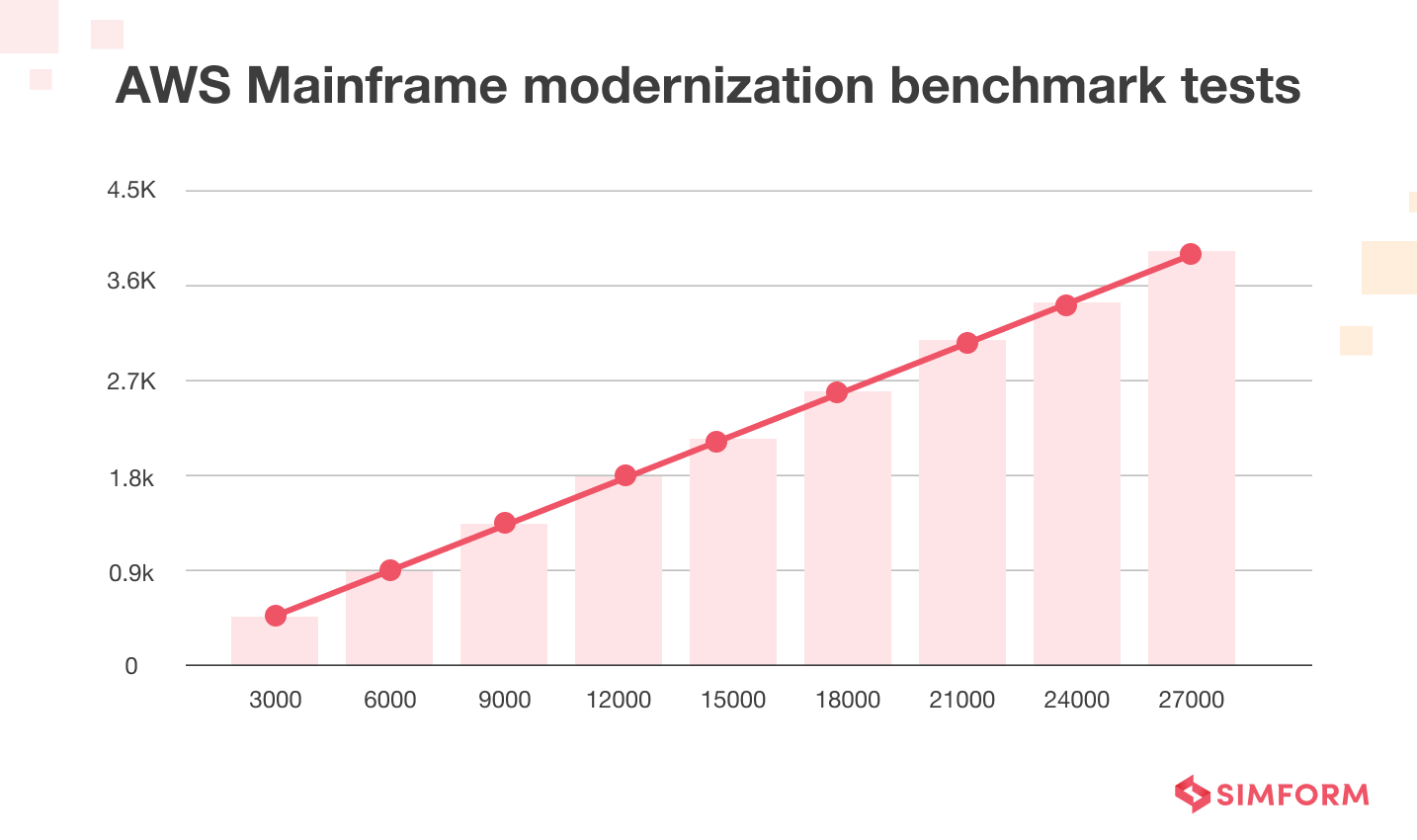
According to a benchmark test conducted by AWS mainframe modernization experts, 9c5.large instances running micro focus enterprise server with a total capacity of 18 virtual CPUs can
- Handle 27,000 virtual user requests.
- Process more than 4,000 tasks per second.
During the scalability tests, task response time was below three milliseconds. The test was conducted at the beginning of a microfocus enterprise server instance, through to data access and completion of the task.
This benchmarking test indicates how AWS services are purpose-built to deliver high-performance, cloud-native responsive, and scalable applications.
#7. Improved resilience and reliability
Resilience is the application’s ability to recover from a failure and self-heal from attacks, while reliability is its ability to meet the expected performance and functionality standards.
AWS provides enhanced resilience and reliability through Well-Architected Framework Reviews (WAFR). It is a framework designed to help AWS partners and customers adopt a consistent approach to evaluate application architectures and execute scalable designs.
The Well-Architected Framework offers best practices around six pillars:
- Operational excellence
- Security
- Reliability
- Performance efficiency
- Cost optimization
- Sustainability
Apart from the WAR framework, AWS also offers many other tools and services that improve resilience to failure and the reliability of applications. The Comcast case study is a wonderful example of how AWS can bring about a huge difference in the resilience of systems.
As one of the significant cable companies in the US, delivering content on a massive scale was a challenge for Comcast. The company witnessed the advantages of highly reliable AWS services when it created the Xfinity X1 platform.
AWS Virtual Private Cloud(VPC) with AWS Direct Connect helped Comcast deploy features for the X1 platform within weeks, maintaining higher reliability across hybrid environments. Similarly, you can leverage AWS tools and services to improve reliability and resilience for your application modifications.
AWS application modernization best practices
AWS tools offer features and automation for efficient modernizations, but optimizing the modernization process requires more than just tools. So, here are some best practices (as recommended in AWS Prescriptive Guidance) to follow for enhanced AWS application modernization.
Learn the strategy for app modernization on the aws cloud
#1. Plan business outcomes
If you plan to modernize applications, the approach needs to be holistic, including all the domains like developer workflows, automation, architecture evolution, etc.
The best way to ensure you cover all the bases is to plan specific business outcomes that AWS application modernization needs to achieve.
While planning the modernization process, your business should ideally plan for three categories of outcomes:
- Business agility is the outcome where your applications deliver according to the organization’s specific requirements. Delivery of functionality per business needs and changing market demands is paramount for organizations. Your AWS application modernization should be planned such that you achieve business agility as the major outcome.
- Organizational agility is when your teams have enhanced collaborations and development best practices to ensure efficiency in cross-departmental processes.
- DevOps culture has to be embraced adequately across the organization to increase throughput and ensure continuous delivery.
- Engineering effectiveness is where your application modernization needs to deliver actual performance, security, and reliability. In other words, the outcome must ensure the implementation of CI/CD pipelines, source code management, configuration management, testing, QA, and more.
When you plan AWS app modernization with the above objectives, you are less likely to invest resources in ineffective processes.
#2. Strategize for each phase of modernization
AWS Prescriptive Guidance emphasizes that application modernization should be an iterative process with three high-level phases: assess, modernize, and manage.
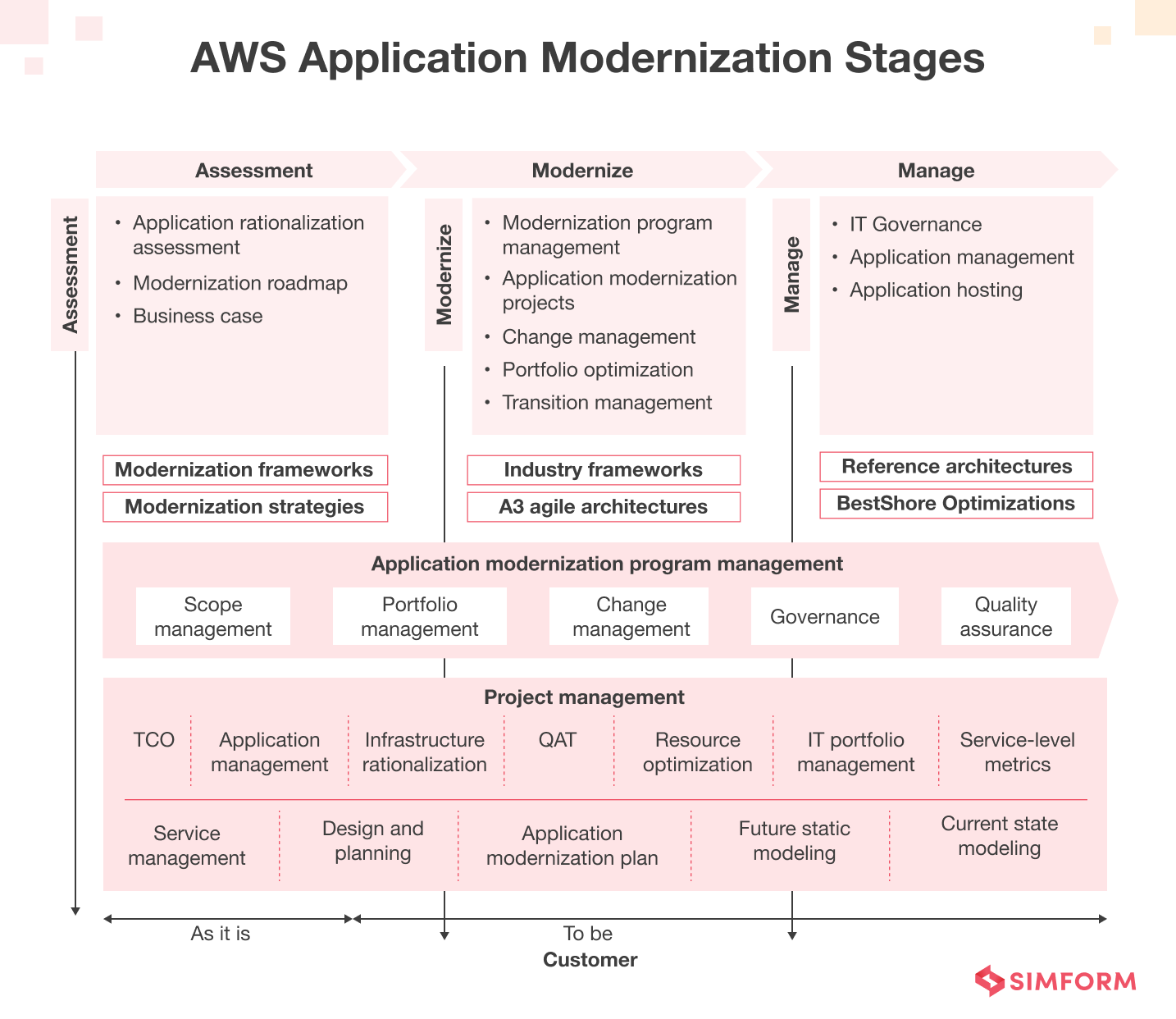
Assess
In the assessment phase, organizations analyze the existing application portfolio and identify systems that need modernization. AWS Prescriptive Guidance says companies must consider the existing technical debt and legacy applications affecting operational capabilities while recognizing the modernization requirements.
It’s best to assess your systems on all the crucial aspects of significance, like business goals, technical and functional needs, the costs involved, etc.
Tips to optimize the assessment phase based on AWS Prescriptive Guidance
- Assess existing application performance and response time to user requests.
- Formalize a governance framework with assigned roles and responsibilities to ensure accurate data assessments.
- Assess the application for strategic or business fit and functional and technical adequacy.
- Document the operating models for existing and modernized applications.
- Verify and validate the scope of application modernization.
Modernize
The modernization phase determines project goals, resource requirements, and roadmap implementation. Here, you can leverage several AWS tools to optimize application modernization costs and outcomes.
Tips to optimize the modernization phase based on AWS Prescriptive Guidance
- Determine the milestones for application modernization along with the timelines.
- Map all the modernization areas, including operating models, standards, and configurations needed for new environments.
- Adopt DevOps to improve collaborations between the development and operations teams.
- Introduce a continuous improvement approach by creating a steady CI/CD pipeline.
- Compare and evaluate different AWS services, tools, and features to use the most suitable for your modernization project.
- Ensure testing and monitoring with advanced observability provided by AWS tools.
Manage
Application modernization does not end with refactoring or rebuilding a new architecture. You need effective change management, program management, QA, and service excellence to manage the modernization process end-to-end. So, the management phase ultimately ensures that all the aspects of site reliability engineering are met, and optimal business outcomes are achieved.
Tips to optimize the management phase
- Ensure teams adjust to the change at an organizational level.
- Use agile methodologies to leverage an iterative approach.
- Make sure the changes in the application due to modernization do not disrupt operations.
- Use automation for testing and ensure enhanced QA for optimized service delivery.
#3. Monitor key metrics
AWS application modernization requires effective metrics monitoring to ensure you achieve pre-defined results from the process. Some of the critical application modernization metrics to monitor are:
- MTTR- Mean time to recovery is the time it will take your systems to get back up and running after an incident.
- MTBF- Mean time between failures measures the average time elapsed before a component fails again.
- CAPA- Capacity, Availability, Performance, and Affordability measures how well your company meets its capacity needs, availability goals, performance goals (within budget), and affordability objectives.
- User satisfaction ratings (USRs) measure users’ satisfaction with an application or service. By monitoring the rates at which users are dissatisfied, organizations can identify areas needing improvement.
Monitoring the metrics is essential for organizations as it helps them understand modernization gaps and adjust strategies accordingly.
#4. Fine-tune modernization strategies
Identify Amazon Web Services (AWS) modernization strategies that can be fine-tuned based on system performance metrics. You can also leverage a modernization strategy, which involves improving resource allocation within the infrastructure to improve overall application response time.
System throughput may be evaluated by monitoring the number of requests per second processed. This information can then be used to identify areas within the codebase where additional optimization may be necessary.
Improving system response time through optimizing infrastructure allocation could involve tuning settings such as memory usage, CPU cores, and I/O performance.
#5. Repeat, track, and refine
Repeating the entire AWS modernization process, tracking key metrics, and continuous refinement are critical to the continued success of your business. Every AWS modernization process involves three essential steps that you need to repeat, track and refine.
Step-1 Consolidating and standardizing AWS cloud applications
The first step in AWS application modernization is consolidating and standardizing AWS cloud applications. Here are some ways to consolidate AWS cloud applications:
- Assess your current application landscape- Conduct an inventory of all your applications, their dependencies, and their current state to understand the scope of standardization.
- Define your standardization criteria-Determine the criteria you will use to standardize your applications. This could include factors such as language, framework, or deployment strategy.
- Create a consolidation plan-Based on your inventory and standardization criteria, and develop a plan to consolidate your applications which can involve migration to a new platform or refactoring.
- Leverage AWS services- AWS provides various services for application modernization, such as AWS Lambda, AWS Elastic Beanstalk, and AWS App Runner for deploying containerized applications.
- Monitor and optimize-Use AWS services such as AWS CloudWatch to monitor application metrics and identify areas for improvement.
Step-2 Automating the deployment of new AWS services
The second step is automating the deployment of new AWS services. You can leverage automation tools to manage cloud application deployments and automated provisioning mechanisms for rapid releases.
You can use automation tools like AWS CloudFormation or AWS CodeDeploy to streamline the deployment process. This can help ensure consistency and reduce errors.
Step-3 Optimizing performance and scaling capacity
Lastly, it is essential to optimize performance and scale capacity. This can be accomplished by deploying clustered solutions, adding more instances, and using data compression techniques. Additionally, proper sizing of Amazon EC2 resources should be considered when launching an AWS modernization project.
Further, you can reduce maintenance and operations costs by manually automating tasks. Another critical factor in achieving success with AWS modernization is proper sizing when deploying new applications or scaling old ones.
By taking into account data compression techniques, cluster solutions, and right-sizing Amazon EC2 resources, it is possible to quickly scale up or down an application’s functionality.
Top tools for AWS application modernization
In addition to Amazon Web Services Prescriptive Guidance for migration and modernization, AWS also offers tools that provide different benefits ranging from on-demand scaling, security, and agility to enhanced modernizations. You can leverage the following tools for your AWS application modernization projects.
#1. AWS Lambda
AWS Lambda is an event-driven computing platform that provides serverless capabilities with advanced computing services. It allows you to run code without provisioning servers or resource management. Lambda functions are triggered due to specific events like changes in data, user actions, or any other system event.
The best part of AWS Lambda is its flexibility which enables tech teams to deploy functions on demand without manual server management.
#2. Amazon ECS
This tool can be used to implement containerization for AWS application modernizations. Amazon ECS is a fully managed containerization service for docker containers that allows you to deploy, scale, and manage containerized applications.
Amazon ECS is an excellent choice if you want to use containerization to modernize applications and implement the microservice architecture.
#3. AWS EKS
If you are looking for a managed containerization service for your projects, AWS offers Amazon Elastic Kubernetes Service(EKS.). It is a tool that provides managed Kubernetes services for organizations to run their apps across hybrid environments.
You can run applications on Kubernetes by integrating other tools like CloudWatch, Auto-scaling groups, and IAM for a seamless experience. Amazon EKS provides container management services that natively integrate with Kubernetes to deploy apps.
#4. AWS Fargate
AWS application modernization with containerized workloads is an excellent strategy but with a caveat. You need to configure and manage the underlying infrastructure. AWS Fargate solves this problem by automating provisioning, managing, and scaling infrastructure.
It is a serverless computing engine that can run containers without manual configuration management. You can use it with Amazon ECS/EKS to simplify application modernization.
#5. AWS S3
Amazon Simple Storage Service(S3) offers scalable, high-speed, and web-based cloud infrastructure to store and recover information from anywhere in the device. You can leverage Amazon S3 and store data in buckets accessible from anywhere remotely.
Moreover, Amazon S3 comes with features such as storage classes that enable organizations to categorize and store data per custom requirements. For example, you can store mission-critical data on Amazon S3 Standard class while archiving data at the lowest cost on Glacier.
#6. CloudWatch
Amazon CloudWatch is a monitoring service that allows users to collect and monitor information for AWS infrastructure in a single platform. It improves organizations’ observability and ensures that applications are resilient to disruptions during the modernization process.
You can use CloudWatch to monitor app infrastructure, network, and all the other services. Using this tool, you can improve the mean time to resolution(MTTR) and recover your systems from failure faster.
#7 AWS IAM
Identity and Authentication Management(IAM) is an essential AWS application modernization tool. This tool lets you define data access and permissions on a granular level and ensure security.
AWS IAM has many features, including identity federation, multi-factor authentication, shared accounts access, and data protection across cloud environments.
#8. Amazon RDS
Amazon Relational Database Service(RDS) automates several aspects of database administration to improve productivity and business focus on application development. Some critical database administration tasks that Amazon RDS automates are failover, backups, system restoration to a specific point in time, disaster recovery, access management, encryption, and secure networking.
Amazon RDS offers the flexibility of choosing a relational database of your choice due to compatibility with PostgreSQL, MySQL, and more.
Modernize your applications with AWS tools’ efficiency and Simform’s expertise
AWS application modernization can offer significant cost reduction advantages, improved efficiency, and resilience. However, it is important to get the implementation right to achieve these benefits.
You must plan for different stages of modernizing your applications using different AWS tools and services. Identifying suitable AWS services requires an experienced partner, and that is where Simform can help.
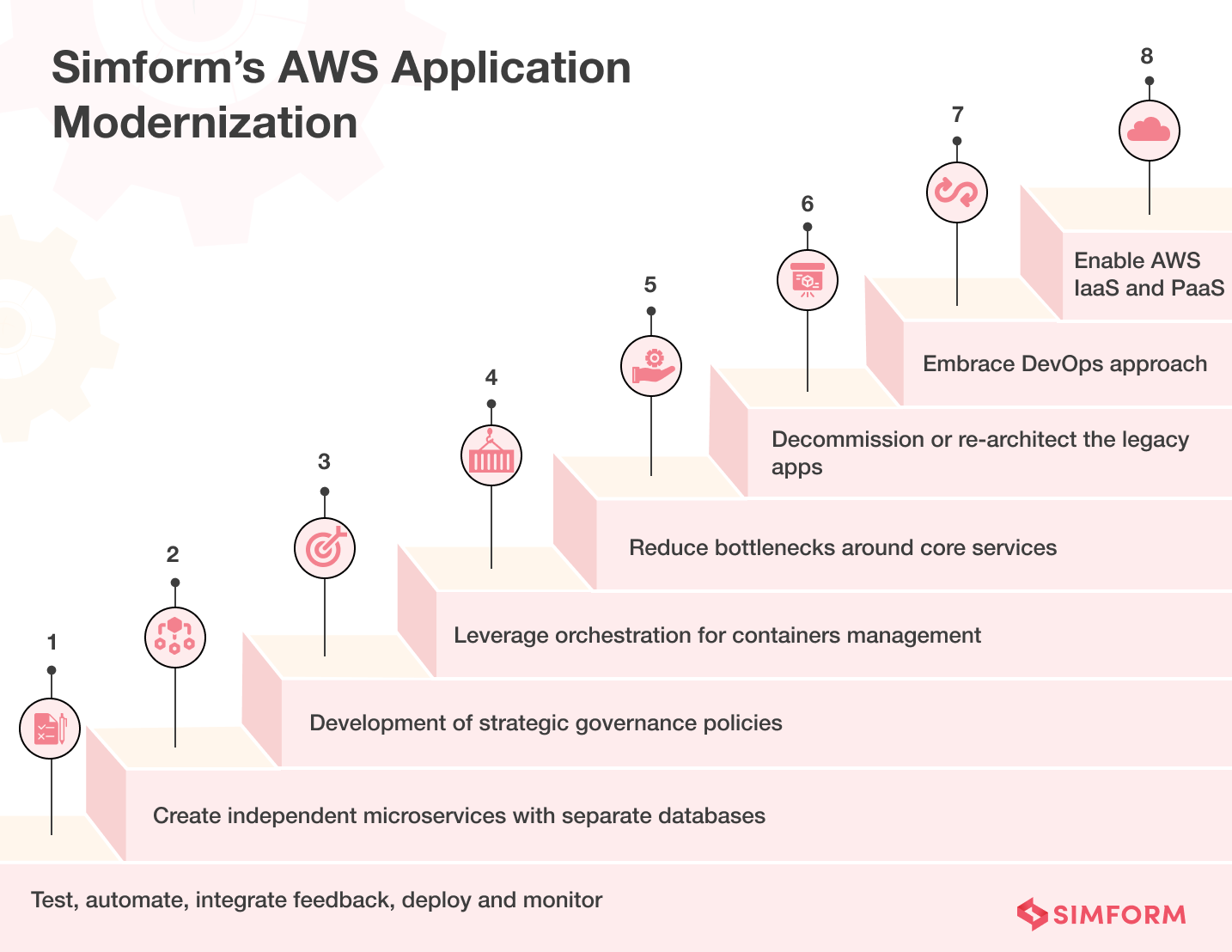
Our AWS application modernization involves:
- Enabling AWS IaaS and PaaS as per business requirements
- Embracing a DevOps approach to strengthen AWS application modernization
- Development of strategic governance policies
- Leverage orchestration for containers management
- Reduce bottlenecks around core services and improve performance
- Identify legacy applications and analyze the need
- If not needed, decommissioning or re-architecting the legacy apps as per need
- Create independent microservices with separate databases
- Test, automate, integrate feedback, and deploy
- Monitor the performance of the modernized applications
So, if you are looking for AWS application modernization services, Simform offers a streamlined process that ensures maximum ROI. Contact us now!